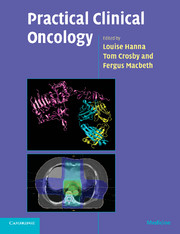Book contents
- Frontmatter
- Contents
- List of contributors
- Preface
- Acknowledgements
- Abbreviations
- 1 Practical issues in cytotoxic chemotherapy usage
- 2 Biological treatments in cancer
- 3 Hormones in cancer
- 4 Radiotherapy planning
- 5 Research in cancer
- 6 Oncological emergencies
- 7 Palliative care
- 8 Head and neck
- 9 Oesophagus
- 10 Stomach
- 11 Liver, gallbladder and biliary tract
- 12 Exocrine pancreas
- 13 Colon and rectum
- 14 Anus
- 15 Gastrointestinal stromal tumours
- 16 Breast
- 17 Kidney
- 18 Bladder
- 19 Prostate
- 20 Testis
- 21 Penis
- 22 Ovary
- 23 Body of the uterus
- 24 Cervix
- 25 Vagina
- 26 Vulva
- 27 Gestational trophoblast tumours
- 28 Lung
- 29 Mesothelioma
- 30 Soft tissue and bone tumours in adults
- 31 The lymphomas and myeloma
- 32 Central nervous system
- 33 Skin cancer other than melanoma
- 34 Melanoma
- 35 Thyroid
- 36 Neuroendocrine tumours
- 37 Cancer in children
- 38 Cancer of unknown primary
- 39 The use of radiotherapy in the treatment of benign conditions
- Multiple choice questions
- Multiple choice answers
- Index
- References
35 - Thyroid
Published online by Cambridge University Press: 23 December 2009
- Frontmatter
- Contents
- List of contributors
- Preface
- Acknowledgements
- Abbreviations
- 1 Practical issues in cytotoxic chemotherapy usage
- 2 Biological treatments in cancer
- 3 Hormones in cancer
- 4 Radiotherapy planning
- 5 Research in cancer
- 6 Oncological emergencies
- 7 Palliative care
- 8 Head and neck
- 9 Oesophagus
- 10 Stomach
- 11 Liver, gallbladder and biliary tract
- 12 Exocrine pancreas
- 13 Colon and rectum
- 14 Anus
- 15 Gastrointestinal stromal tumours
- 16 Breast
- 17 Kidney
- 18 Bladder
- 19 Prostate
- 20 Testis
- 21 Penis
- 22 Ovary
- 23 Body of the uterus
- 24 Cervix
- 25 Vagina
- 26 Vulva
- 27 Gestational trophoblast tumours
- 28 Lung
- 29 Mesothelioma
- 30 Soft tissue and bone tumours in adults
- 31 The lymphomas and myeloma
- 32 Central nervous system
- 33 Skin cancer other than melanoma
- 34 Melanoma
- 35 Thyroid
- 36 Neuroendocrine tumours
- 37 Cancer in children
- 38 Cancer of unknown primary
- 39 The use of radiotherapy in the treatment of benign conditions
- Multiple choice questions
- Multiple choice answers
- Index
- References
Summary
Introduction
Thyroid cancer consists of a diverse group of tumours with different clinical features and prognoses. Thyroid cancer can occur at any age, but it is rare in patients under the age of 25. Radiation exposure is the best-documented risk factor. Most thyroid cancers are carcinomas: these are papillary, follicular, medullary, and anaplastic, in order of frequency. Thyroid lymphomas and sarcomas are rarer. The overall prognosis is related to histological type; well-differentiated thyroid cancer (papillary and follicular) has the best prognosis. In contrast, anaplastic carcinoma progresses rapidly and has a very poor prognosis. There is a lack of evidence from prospective randomised controlled studies because differentiated thyroid cancer is an uncommon disease with a long natural history. Many areas of thyroid cancer management remain controversial, including the extent of surgery and the indications for radioiodine ablation and radiotherapy. Evidence-based guidelines published in 2002 relied on large retrospective and cohort studies (British Thyroid Association, 2002).
This chapter focuses mainly on differentiated thyroid cancer, with shorter sections on medullary thyroid carcinoma (MTC), anaplastic thyroid cancer and thyroid lymphoma.
Types of thyroid tumour
Thyroid tumours can be divided into benign, malignant primary and malignant secondary. Types of thyroid tumour are shown in Table 35.1.
The relative proportions of patients with differentiated thyroid cancer in a geographic area depend on dietary iodine intake. The proportion of follicular cancers increases where there is dietary iodine deficiency.
- Type
- Chapter
- Information
- Practical Clinical Oncology , pp. 406 - 417Publisher: Cambridge University PressPrint publication year: 2008

